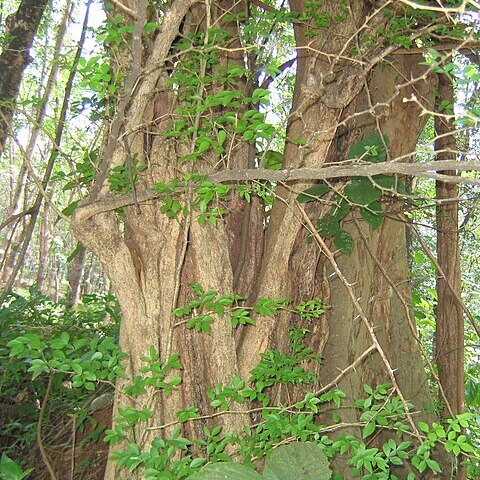| Therapeutic use
|
Anthelmintics (bark), Anti-bacterial agents (bark), Anticonvulsants (bark), Antifungal agents (bark), Anti-infective agents, local (bark), Antipyretics (bark), Antirheumatic agents (bark), Appetite stimulants (bark), Asthenia (bark), Asthma (bark), Cholera (bark), Colic (bark), Cough (bark), Deodorants (bark), Diabetes mellitus (bark), Diarrhea (bark), Diuretics (bark), Dyspepsia (bark), Dyspnea (bark), Ear diseases (bark), Earache (bark), Epilepsy (bark), Eye diseases (bark), Fever (bark), Flatulence (bark), Gout (bark), Graves ophthalmopathy (bark), Headache (bark), Heart diseases (bark), Helminthiasis (bark), Hypohidrosis (bark), Laryngeal diseases (bark), Leprosy (bark), Liver diseases (bark), Migraine disorders (bark), Mouth diseases (bark), Neoplasms (bark), Paralysis (bark), Parasympatholytics (bark), General tonic for rejuvenation (bark), Scabies (bark), Skin diseases (bark), Splenic diseases (bark), Stomatitis (bark), Toothache (bark), Toothbrush (bark), Ulcer (bark), Urination disorders (bark), Vitiligo (bark), Wounds and injuries (bark), Analgesics (fruit), Anthelmintics (fruit), Anti-bacterial agents (fruit), Anticonvulsants (fruit), Antifungal agents (fruit), Anti-infective agents, local (fruit), Antipyretics (fruit), Antirheumatic agents (fruit), Appetite stimulants (fruit), Asthenia (fruit), Asthma (fruit), Colic (fruit), Cough (fruit), Deodorants (fruit), Diabetes mellitus (fruit), Diarrhea (fruit), Diuretics (fruit), Dyspepsia (fruit), Dyspnea (fruit), Ear diseases (fruit), Earache (fruit), Epilepsy (fruit), Eye diseases (fruit), Fever (fruit), Fishes, poisonous (fruit), Flatulence (fruit), Gout (fruit), Graves ophthalmopathy (fruit), Headache (fruit), Heart diseases (fruit), Helminthiasis (fruit), Hypohidrosis (fruit), Laryngeal diseases (fruit), Leprosy (fruit), Liver diseases (fruit), Migraine disorders (fruit), Mouth diseases (fruit), Neoplasms (fruit), Paralysis (fruit), Parasympatholytics (fruit), General tonic for rejuvenation (fruit), Scabies (fruit), Skin diseases (fruit), Splenic diseases (fruit), Stomatitis (fruit), Tooth diseases (fruit), Toothache (fruit), Toothbrush (fruit), Ulcer (fruit), Urination disorders (fruit), Vitiligo (fruit), Wounds and injuries (fruit), Anthelmintics (seed), Anti-bacterial agents (seed), Antifungal agents (seed), Ascariasis (seed), Cholera (seed), Dyspepsia (seed), Fever (seed), General tonic for rejuvenation (seed), Scabies (seed), Tooth diseases (seed), Appetite stimulants (stem), Fishes, poisonous (stem), Flatulence (stem), Hypoglycemia (stem), Toothache (stem), Appetite stimulants (thorns/spines/prickles), Fishes, poisonous (thorns/spines/prickles), Flatulence (thorns/spines/prickles), Hypoglycemia (thorns/spines/prickles), Toothache (thorns/spines/prickles), Abscess (unspecified), Ache(Stomach) (unspecified), Arthritis (unspecified), Bite(Snake) (unspecified), Bruise (unspecified), Enteritis (unspecified), Gastritis (unspecified), Swelling (unspecified), Trauma (unspecified), Vermifuge (unspecified), Ascariasis (unspecified), Rheumatism (unspecified), Antiseptic (unspecified), Aromatic (unspecified), Carminative (unspecified), Cholera (unspecified), Dentifrice (unspecified), Deodorant (unspecified), Dyspepsia (unspecified), Hair-Oil (unspecified), Hyperglycemia (unspecified), Insecticide (unspecified), Repellant(Insect) (unspecified), Scabies (unspecified), Stomachic (unspecified), Bactericide (unspecified), Fever (unspecified), Fungicide (unspecified), Odontitis (unspecified), Piscicide (unspecified), Hypoglycemic agents (unspecified), Appetite stimulants (whole plant), Flatulence (whole plant)
|


